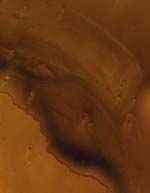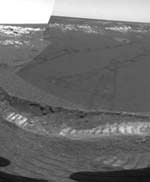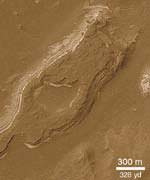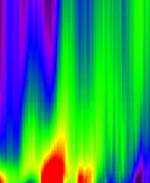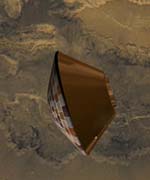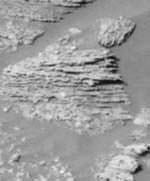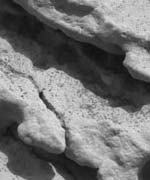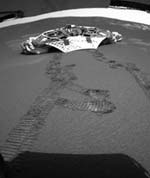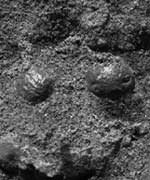
Image credit: NASA/JPL
Because the rover Opportunity found spherical granules around its landing site on Mars, researchers put it to work digging a trench to see if they were also beneath the surface. Microscopic imager pictures now show that the granules, millimeters in size and dubbed “blueberries,” also are embedded in the walls of the trench.
And the images show the blueberries are polished and shiny. “We’re not sure what is going on here, but there is some process happening at the subsurface, said Mars rover science team member Albert Yen at a press conference at the Jet Propulsion Laboratory (JPL) in Pasadena today (Feb. 19).
Science team leader Steven Squyres, Cornell professor of astronomy, told the press briefing that he expects the spherical granules to be common over most of the Martian surface. But, he said, “We don’t know what their pedigree is.”
To find out, Opportunity is about to embark on a trip to what he called “a blueberry patch,” a “wonderful finely layered laminated bedrock” dubbed El Capitan, where it’s known there are many of the granules. The exposed bedrock has a gently sloping lower portion and a much steeper upper portion, overhanging in places. The aim is, Squyres said, to “zero in on a place where there are lots of those spherical granules and look in detail with the microscopic imager.” The rover is exploring a crater in an area of Mars called Meridiani Planum.
The intention also is to grind away the rocks’ outer layers with the rover’s rock abrasion tool and put the rover’s alpha-praticle X-ray spectrometer (APXS) up against the rock to see if it is sulfur rich all the way through. The rover’s M?ssbauer spectrometer also will be used to see what minerals are present.
There are, said Squyres, basically three questions that Opportunity is trying to answer. First, how were these materials deposited — by air or by water? Second, where did the blueberries embedded in the outrcop come from — were they dropped in from above, or did they grow in place? Third, what is the composition of the outcrop and “What does it tell us or not tell us about the possibility that water was involved in forming the minerals that are in this outcrop?”
The yellow line shows Spirit’s path so far. Click on the image for a high-resolution version (889 x 723 pixels, 360K)
Yen also noted that microscopic imaging of sand-size grains in the trench show they were cemented together. He referred to a theory going back to the Viking mission that water vapor exchanged between the Martian atmosphere and the subsurface could mobilize salts in the upper few centimeters of the surface, depositing a weak cement that could hold granules together. “We are looking for evidence of any salt products that might hold the grains together,” he said.
Possible evidence of salts also was mentioned by Dave Des Marais, a science team member from NASA-Ames Laboratory, in describing the latest data from Opportunity’s twin, Spirit, in Gusev crater on the opposite side of Mars. Spirit has been investigating Laguna Hollow, a depression containing fine grain material. After the rover wiggled its right front wheel and backed up and turned, it was found that some of the material was sticking to the wheel. Des Marais suggested that the stickiness might result from salt or brine. The plan is, he said, to dig a trench and look for evidence of brine moving up to the surface, evaporating and depositing salt at the surface.
Both rovers, it seems, have an abundance of time to carry out their investigations. Squyres noted that both vehicles’ power and thermals systems “are holding up spectacularly well.” And although the mission originally was expected to last about 90 Martian days, or sols, “I will say that I have talked to people at my apartment complex about staying through the summer,” he said.
Original Source: Cornell News Release

